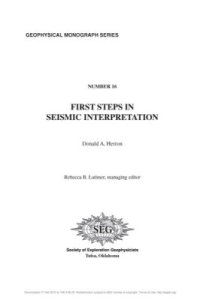
Ebook: Herron. First Steps in Seismic Interpretation
Author: Donald A.
- Genre: Physics // Geophysics
- Tags: Горно-геологическая отрасль, Геофизика, Сейсморазведка
- Language: English
- zip
Tulsa, Society of Exploration Geophysicists, 2011. — 203 p. — (Geophysical Monograph Series). — ISBN 978-0-931830-56-3.This book begins with an introduction that is more philosophical than technical, followed by five chapters on fundamentals of reflection seismic (titled Seismic Response, Seismic Attributes, Velocity, Migration, and Resolution). The gist of what I really have to say about the correlation of seismic records is in Chapters 7 (Correlation Concepts) and 8 (Correlation Procedures). Chapter 9 (Data Quality and Management) certainly should not be glossed over, and Chapter 10 (Other Considerations) contains my thoughts on several worthy topics that do not fit neatly into any of the preceding chapters.
In large part, this book is a compilation of notes from seismic interpretation courses that I’ve had the good fortune to teach over the past three decades. Because I’ve assumed that readers are familiar with basic concepts and principles of geology and reflection seismology, the book is best viewed as a synthesis rather than a fundamental treatment of those concepts and principles. When I use the expression geologically reasonable to qualify interpretation results, which I do throughout the book, I mean reasonable in the sense of analogous to known geology or consistent with known geology or sound geologic models or within the context of expectation or
realization of some geologic concept or model.
I certainly don’t intend this book to be the definitive primer on interpreting reflection seismic data or a comprehensive treatise on the latest in correlation tools and techniques; rather, I’m seeking to give voice to a concern about this particular art that I’ve had ever since my first foray into interpretation in the early 1970s. My concern is founded on a statement by a man from whom I had the privilege to learn about exploration geophysics in the classroom and in the field. In his own book he wrote that the correlation procedure itself is of such a nature that it can hardly be adequately described in a book.
Well, with the utmost respect for that man, here goes.About the Author.
Preface.
Acknowledgments.
Introduction.
Seismic Response.
Seismic Attributes.
Amplitude.
Coherence.
Inversion.
Velocity.
Sonic logs.
Well-velocity surveys.
Seismically derived velocities.
Velocity anisotropy.
Time-depth conversion.
Migration.
Resolution.
Correlation Concepts.
First look.
Horizons versus faults.
Multiple reflections.
Manual versus automatic tracking.
Artifacts and interpretation pitfalls.
Correlation Procedures.
Getting started.
Loop tying.
Jump correlation.
Correlations in depth-migration projects visualization.
Interpretation processes and work flows.
Data Quality and Management.
Data quality.
Data management.
Nomenclature systems.
Other Considerations.
Gridding and contouring.
D seismic.
Seismic modeling.
Interpretive judgment.
Curiosity and interpretive thinking.
The interpretation paradox.
Approximations.
Uncertainty and risk.
The workstation environment.
Ergonomics.
Presentations.
Career development.
Advanced interpretation.
Time spent and value added.
References.
Index.
In large part, this book is a compilation of notes from seismic interpretation courses that I’ve had the good fortune to teach over the past three decades. Because I’ve assumed that readers are familiar with basic concepts and principles of geology and reflection seismology, the book is best viewed as a synthesis rather than a fundamental treatment of those concepts and principles. When I use the expression geologically reasonable to qualify interpretation results, which I do throughout the book, I mean reasonable in the sense of analogous to known geology or consistent with known geology or sound geologic models or within the context of expectation or
realization of some geologic concept or model.
I certainly don’t intend this book to be the definitive primer on interpreting reflection seismic data or a comprehensive treatise on the latest in correlation tools and techniques; rather, I’m seeking to give voice to a concern about this particular art that I’ve had ever since my first foray into interpretation in the early 1970s. My concern is founded on a statement by a man from whom I had the privilege to learn about exploration geophysics in the classroom and in the field. In his own book he wrote that the correlation procedure itself is of such a nature that it can hardly be adequately described in a book.
Well, with the utmost respect for that man, here goes.About the Author.
Preface.
Acknowledgments.
Introduction.
Seismic Response.
Seismic Attributes.
Amplitude.
Coherence.
Inversion.
Velocity.
Sonic logs.
Well-velocity surveys.
Seismically derived velocities.
Velocity anisotropy.
Time-depth conversion.
Migration.
Resolution.
Correlation Concepts.
First look.
Horizons versus faults.
Multiple reflections.
Manual versus automatic tracking.
Artifacts and interpretation pitfalls.
Correlation Procedures.
Getting started.
Loop tying.
Jump correlation.
Correlations in depth-migration projects visualization.
Interpretation processes and work flows.
Data Quality and Management.
Data quality.
Data management.
Nomenclature systems.
Other Considerations.
Gridding and contouring.
D seismic.
Seismic modeling.
Interpretive judgment.
Curiosity and interpretive thinking.
The interpretation paradox.
Approximations.
Uncertainty and risk.
The workstation environment.
Ergonomics.
Presentations.
Career development.
Advanced interpretation.
Time spent and value added.
References.
Index.
Download the book Herron. First Steps in Seismic Interpretation for free or read online
Continue reading on any device:

Last viewed books
Related books
{related-news}
Comments (0)